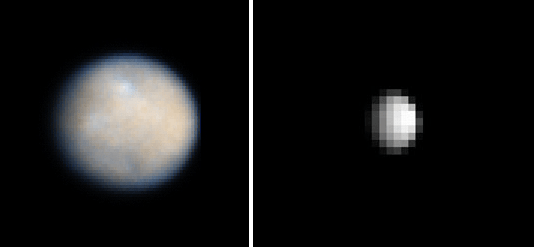The Hubble Space Telescope is one of the best observatories humanity has. It’s been operating for nearly 25 years in space, is still highly productive, and is a key element to mission planning for NASA as it sends spacecraft out into the Solar System. When the agency was getting ready to send Dawn to Vesta, for example, it took pictures to help with calibration.
Then Dawn got up close to the dwarf planet in 2011 and found a few surprises — liquid water that possibly flowed temporarily on the surface, for example. And as the spacecraft draws near to Ceres for a close encounter next year, it also will be looking for water — in the form of its atmosphere.
That’s following on from research out of the Herschel Space Telescope published earlier this year, showing that Ceres has a thin water vapor atmosphere surrounding the dwarf planet. It could be producing water similarly to how a comet does, through sublimation, but investigators won’t know much until they get close-up.
“Ceres has some sort of mechanism that’s putting out water vapor and causing a thin, temporary atmosphere,” said Keri Bean, a mission operations engineer at the Jet Propulsion Laboratory who works on Dawn, in a Google+ Hangout yesterday (Dec. 11). “I think that we’re going to try to look into this, and we don’t know what else Ceres will have in store for us.”

Dawn is now so close to Ceres that its pictures will soon exceed the best ones Hubble had to offer. The image above (at right) is modest compared to the space telescope, but in a planned photo session Jan. 26 Dawn will have slightly better pictures than Hubble. By Feb. 4 they will be twice as good in quality and then seven times as good Feb. 20.
The spacecraft’s images not only have science purposes, as they let investigators study the surface, but also serve as optical navigation aids. Ceres is a tiny body and hard to navigate to from far away, so as it gets closer these pictures are crucial for Dawn to figure out where to go next.
Dawn will get its close-up of Ceres in the spring when it arrives at the dwarf planet. To get the latest on the mission, check out the entire Google+ Hangout from yesterday.

